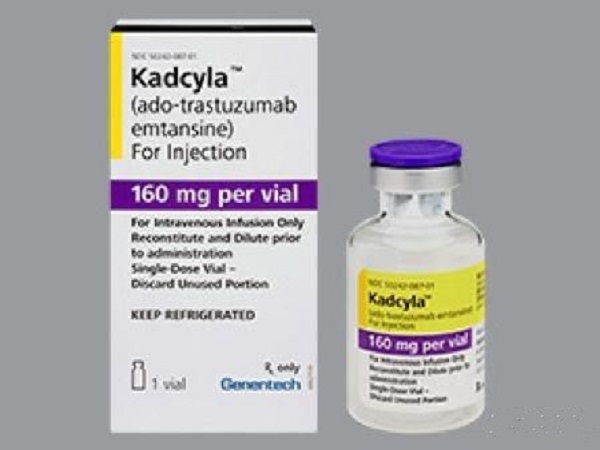

However, a much more modest benefit of T-DM1was seen in pertuzumab pre-treated patients. Women who received the ADC experienced a more favorable safety profile in comparison to the control arm, raising the possibility that T-DM1 might displace trastuzumab-based chemotherapy regimens. T-DM1 was also found to be superior to any physician’s choice in heavily pre-treated patients with prior exposure to trastuzumab and lapatinib.
T DM1 CLINICAL TRIALS REGISTRATION
In the registration clinical trial comparing T-DM1 to capecitabine and lapatinib, T-DM1 significantly improved progression-free (PFS) and overall survival in women who had previously received trastuzumab and a taxane for the treatment of metastatic disease. T-DM1 is an antibody-drug conjugate (ADC) in which trastuzumab is coupled to a derivative of the potent inhibitor of microtubule polymerization maitansine: it enables the delivery of the cytotoxic drug to cells expressing HER2 with potential to increase therapeutic index and decrease off-target effects. Antibody-drug conjugates have been developed, such as trastuzumab emtansine (also known as T-DM1), with the intention of delivering anti-HER2 treatment with a cytotoxic conjugate that has reduced side-effects compared to traditional systemic cytotoxic agents. ĭrugs that target HER2 are usually tolerated well (especially trastuzumab and pertuzumab), but toxicity arises with and without concurrent use of chemotherapy. However, the addition of pertuzumab to a trastuzumab-containing adjuvant regimen improves DFS only modestly, a finding seen only in women with the poorest outcomes (e.g.

In women with localized HER2-positive disease, the addition of trastuzumab to adjuvant chemotherapy significantly and substantially improves disease-free survival (DFS) and overall survival. The addition of pertuzumab, an antibody that targets the dimerization arm located in subdomain II of the extracellular region of HER2, to trastuzumab and a taxane as first line treatment, provides an improvement in median survival of more than a year in women with HER2-positive metastatic breast cancer. Women with metastatic HER2-positive BC receiving anti-HER2 therapy now have a median survival of more than 50 months with an estimated 5 year survival of 34%, a substantial improvement from results observed 20 years ago. Patients with ERBB2 oncogene amplification or HER2 receptor overexpression (HER2-positive) experience a substantial improvement in survival with trastuzumab-based therapy.

This led to the subsequent development of trastuzumab, an antibody that targets subdomain IV in the extracellular region of HER2. The discovery of the potent oncogenic properties of the HER2 transmembrane tyrosine kinase, followed by its identification as a poor prognostic marker in women whose tumors overexpress HER2, opened the possibility for its therapeutic targeting. Drugs that target the HER2 pathway in breast cancer (BC) provide examples in which early signals found on the laboratory bench reached patients’ bedside. Many promising anti-cancer drugs may be “lost in translation” between pre-clinical and clinical research, although there are exceptions. Treatment advances that dramatically change outcomes in malignant disease continue to be uncommon. In addition, we review ongoing studies that could help to understand these findings. In this article, we discuss basic science and translational data that may explain the limited efficacy observed with the combination of TDM1 and pertuzumab, including tumor heterogeneity, clonal selection, bystander effect or downregulation of the receptor by competitive binding. Similar results were observed when exploring pathologic complete response in the neoadjuvant setting. Unexpectedly, when pertuzumab was explored in combination with the antibody-drug conjugate TDM1 in the metastatic setting, no additional benefit was observed compared with dual targeting of HER2 with pertuzumab and trastuzumab, together with chemotherapy. The addition of pertuzumab, another anti-HER2 antibody, to trastuzumab-containing regimens has demonstrated a modest increase in disease-free survival in the adjuvant setting. Targeting of HER2-positive tumors with trastuzumab has shown to improve survival in early stage and advanced breast cancer. Received: Accepted: JPublished: August 07, 2018 Alberto Ocaña 1, Eitan Amir 2 and Atanasio Pandiella 3ġTranslational Research Unit, Albacete University Hospital, and CIBERONC, Albacete, SpainĢDivision of Medical Oncology and Hematology, Princess Margaret Cancer Centre, University of Toronto, Toronto, CanadaģCancer Research Center, CSIC-IBSAL and CIBERONC, Salamanca, SpainĪlberto Ocaña, email: breast cancer HER2 trastuzumab pertuzumab TDM1


 0 kommentar(er)
0 kommentar(er)
